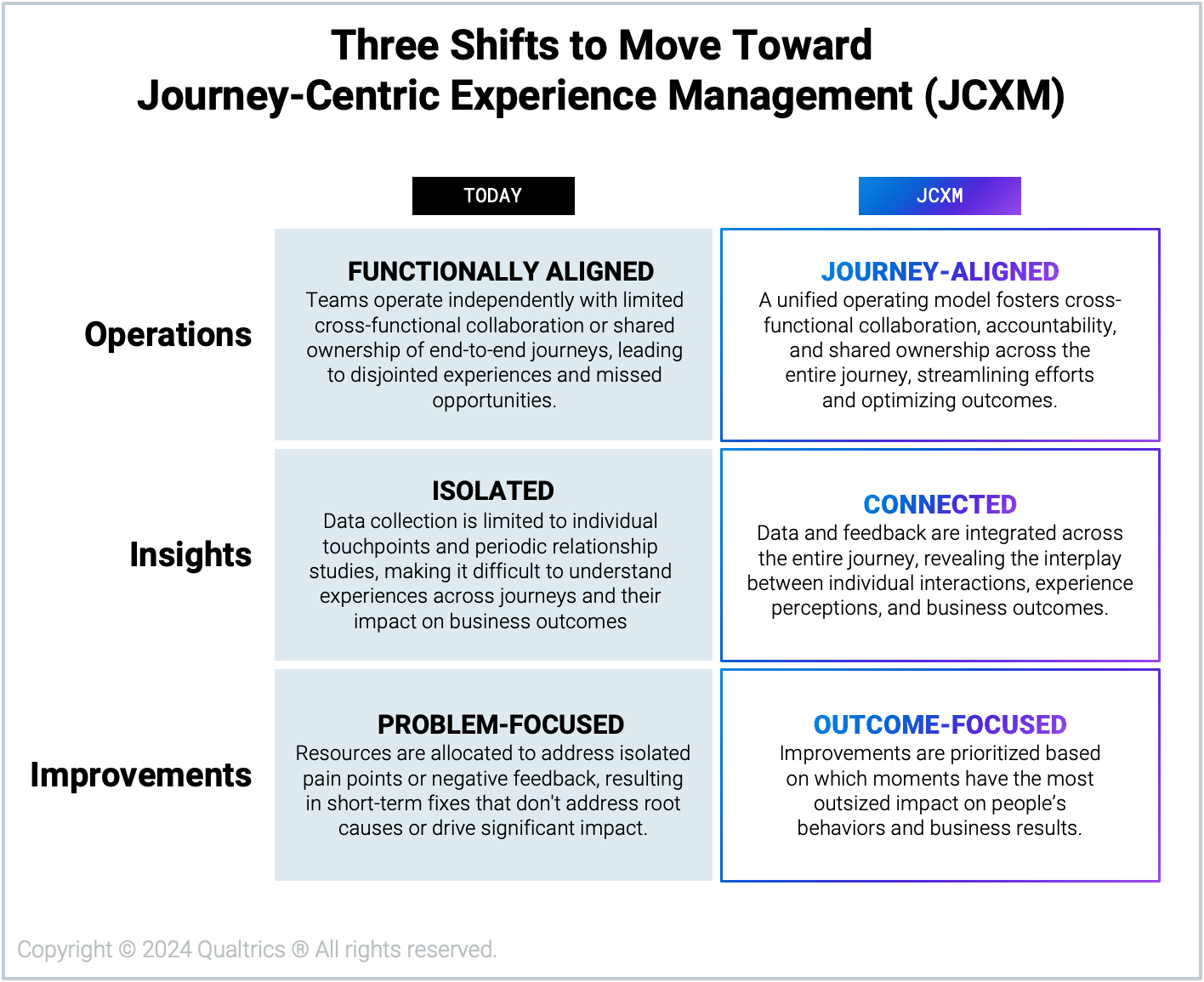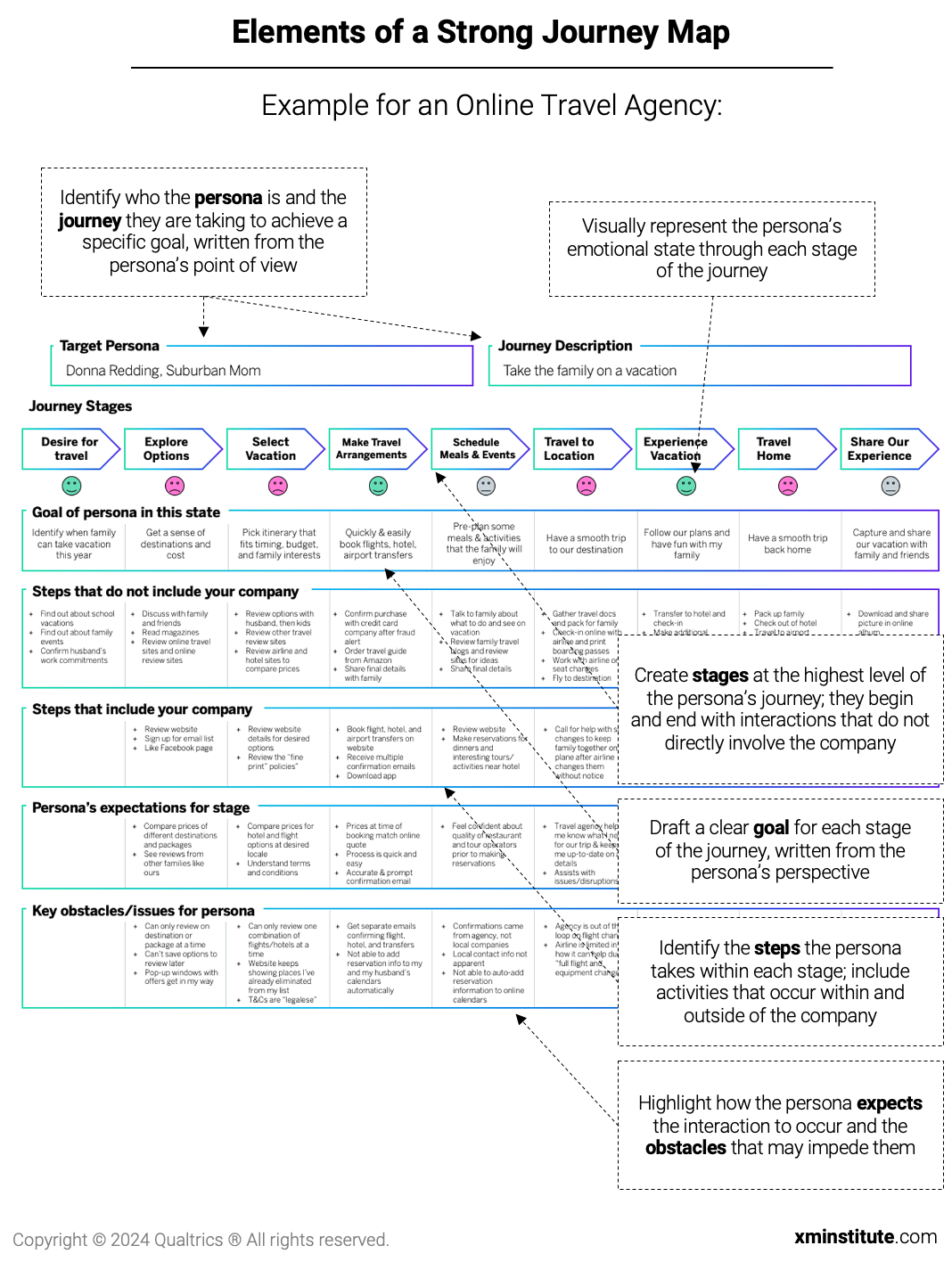Introduction to Journey-Centric Experience Management (JCXM)
Many Experience Management (XM) programs today struggle to deliver on the promise of creating tangible, sustainable value for their business. Often this is because they focus too narrowly on making one-off or periodic improvements to isolated touchpoints. While this may result in some incremental gains in the short term, this type of piecemeal approach ultimately limits the long-term value and transformative potential of XM. It can also lead to costly issues like misaligned activities, wasted resources, disjointed interactions, and band-aid fixes that don’t address underlying problems.
To realize lasting value from their efforts, XM programs need to shift away from improving specific, isolated interactions and instead optimize complete, end-to-end customer or employee journeys. XM Institute calls this “Journey-Centric Experience Management (JCXM),” which refers to:
an approach that aligns XM efforts around journeys to maximize their impact on business and experience outcomes
This approach positions journeys – rather than interactions – as the fundamental unit of analysis, design, and improvement for an XM program. By adopting JCXM, organizations can:
- Optimize investments to drive the greatest value. Not all touchpoints are equally important. “Moments that matter” – the points of greatest emotional intensity along a journey – disproportionately affect people’s perceptions and behaviors during and after their experience. And by extension, they disproportionately affect the business outcomes the organization cares about, like increased customer spend or reduced employee turnover. Because of this outsized influence, to maximize the value of XM efforts, organizations should focus their attention and resources on these moments that matter. Uncovering these moments, however, requires a holistic understanding of people’s end-to-end journeys. Without understanding interactions within their broader context, organizations risk scattering their resources across minor improvements that may or may not generate any value for the business. JCXM enables organizations to identify and then strategically invest in the areas that will have the greatest impact on desired customer outcomes (e.g., higher levels of satisfaction or trust), employee outcomes (e.g., higher levels of well-being or engagement), and business outcomes (e.g., higher profits or productivity).
- Align organizational perceptions of experiences with customer/employee perceptions. There is often a sizable gap between how organizations view customer or employee experiences and how the individuals themselves view their experiences. Organizations tend to consider interactions through the lens of departmental silos or specific channels. Because each internal group is responsible for improving its own isolated set of touchpoints – with limited visibility or accountability across functions – the organizational perspective of experiences is usually fragmented across teams. Customer and employee perceptions, by contrast, are shaped cumulatively along the entire path they take to accomplish a particular goal. They are unaware of (and uninterested in) which group owns which touchpoint. Consider a new hire onboarding process: HR may focus on paperwork, IT on equipment setup, and the hiring manager on team introductions. The employee, however, views it as a single, cohesive journey toward becoming a productive team member. Because a journey-led approach to XM is anchored in the perspective of a target customer or employee, it allows the organization to systematically design and deliver experiences that reflect the needs of the individual, rather than internal business structures.
- Uncover root causes. Most experience improvement efforts today zero in on isolated issues in response to explicit customer or employee complaints. While this may result in incremental, surface-level fixes, it doesn’t help organizations uncover and address the underlying root causes leading to those poor experiences. As a result, XM efforts get stuck in reactive firefighting mode, constantly forced to respond to urgent issues as they arise rather than eliminating problems at their source. A journey-centric approach helps organizations identify patterns across interactions and departments, allowing them to tackle the systemic issues – like broken processes, poor communication, skewed incentives, or technology gaps – that are ultimately causing the downstream problems.
- Create consistent, on-brand experiences. Even if each individual interaction is executed perfectly, without any central alignment or coordination, people’s experiences will feel disjointed. A journey-centric approach brings together relevant stakeholders from across the organization to understand and design the complete set of activities a customer or employee encounters along their path to accomplish their goal. Because this type of cross-functional coordination creates internal alignment around things like metrics, processes, communication styles, accountability, and design principles, it helps ensure the experiences the organization delivers are consistent and on-brand across all touchpoints, regardless of where they originate from or occur across the business. This holistic framework also helps organizations make sure that they are reinforcing their unique value proposition and living up to their brand values at key points along the journey.
Three Shifts to Move Toward JCXM
Journey-centric activities – especially journey mapping – have been popular in the Experience Management world for a while. Yet most organizations fail to achieve the full value of these efforts because they make only superficial or one-off changes. After an initial burst of enthusiasm and energy, ownership is often relegated to a siloed team with limited control or oversight over the end-to-end experience, resulting in stagnant, outdated journeys. To achieve meaningful, lasting change from their efforts, organizations need to move beyond simply adding a journey lens to existing practices. They need to fundamentally rethink how their customer and employee experiences are designed and managed.
Journey-Centric Experience Management provides a framework for this transformation. It establishes a centralized oversight structure to prioritize, streamline, and accelerate cross-functional XM activities, aligning them all around explicit business objectives and universal guidelines and standards. To start shifting towards JCXM, we recommend XM programs evolve their activities across three areas: Journey-Aligned Operations, Connected Insights, and Outcome-Focused Improvements.

JCXM Shift #1: From Functionally Oriented to Journey-Aligned Operations
Customer and employee journeys naturally transcend departmental boundaries – as do the business opportunities tied to experience improvements. Yet most organizations still operate within functional silos, with limited visibility and ownership across groups. Embracing Journey-Centric Experience Management will require organizations to establish a new, journey-aligned operating model that defines how teams should work together to manage, support, and continuously improve end-to-end journeys. It should include the principles, goals, decision-making frameworks, and day-to-day responsibilities that will guide the organization’s JCXM efforts. Defining this journey-aligned operating model early on will help you lay the necessary foundation for both creating seamless end-to-end experiences and optimizing your internal processes.
While XM teams are often responsible for steering these efforts and establishing the initial structures that will provide the foundation of long-term success, they alone should not “own” customer or employee journeys. Success is ultimately contingent on numerous individuals and groups across the organization driving and supporting journey-centric changes. The goal here is to empower the rest of your organization with the direction, support, and resources they need to adopt this journey-centric approach within their role.
Here are three recommendations to start shifting from functionally oriented to journey-aligned operations:
- Develop a journey-centric vision and strategy. A compelling vision and strategy will act as the North Star for your JCXM efforts, giving groups across the organization a standard they can look to and prioritize against as they make decisions. This vision should articulate the desired future state of the customer or employee journey, highlighting the specific experiences and outcomes you aim to deliver. The exact form this vision takes will depend on your program. If you have already defined an overarching vision statement for your XM program, you could use that to guide your JCXM efforts. You could also create a broad, aspirational vision for managing journeys (e.g., “To provide personalized, effortless experiences that exceed customer expectations at every step along their journey”), which should align with your XM program and brand visions. If you are managing a portfolio of many journeys, you may also consider developing journey-specific outcome statements that reflect the unique goals and desired goals of that particular set of activities (e.g., “To provide timely, empathetic support that resolves customer issues quickly and leaves them feeling valued and appreciated”). Your JCXM strategy may also include guiding principles or brand promises to shape the design and delivery of interactions across the journey, like “we make it easy” or “we are proactive.” Once you know the desired future state for key journeys, build a roadmap for achieving this vision, detailing key milestones, initiatives, and metrics for success. Involve relevant stakeholders throughout the development of these assets, and once they are finalized, develop a communication plan to ensure all relevant parties understand the vision and the role they play in bringing it to life.
- Establish standard processes and practices. To fully embrace a journey-centric approach, organizations will need a set of consistent, well-defined processes and practices. These will provide clear directives on the practical application of JCXM, translating the high-level goals of the previous bullet into tangible procedures and advice to help teams make the vision a reality. This involves integrating disconnected processes across departments, surfacing and codifying best practices, eliminating redundancies and unnecessary steps, and aligning internal workflows with the journey ambition. Start by evaluating existing processes and identifying areas for improvement or integration. Develop a shared toolkit of essential elements, like universal journey definitions, frameworks, playbooks, templates, and FAQs. These resources should also include guidance around common XM activities. For example, you should define standardized feedback and data collection practices, establish universal processes for reviewing and prioritizing JCXM initiatives (e.g., CX or EX prioritization tools), and explain common journey tools and technologies (e.g., journey maps and journey analytics).
- Build journey-centric governance structures. Establish journey-centric governance structures that include clear rules and processes for decision-making, resource allocation, and accountability across JCXM initiatives. To bring this structure to life, assemble a dedicated journey team with clearly defined roles and responsibilities (see Figure 1). This team will become the backbone of your JCXM efforts. In addition to this core team, a strong governance model includes supporting roles like an executive sponsor, working group, and ambassadors. Specify who is responsible for approving journeys, allocating resources for improvement projects, and tracking the effects of these changes. Other activities here include defining a regular operating rhythm (e.g., meeting cadences and communication logistics) as well as how teams collaborate on activities like journey mapping, gathering and analyzing feedback, and employee enablement.
JCXM Shift #2: From Isolated to Connected Insights
Most organizations today operate with a fragmented understanding of customers and employees. While they may measure overall relationship health and the success of individual interactions, this information often resides in separate systems that are owned by different teams. Even when combined, this patchwork of information fails to capture the crucial middle layer – the connective tissue that explains how individual interactions cumulatively influence the overall relationship. This creates an “insights black hole,” a gap in understanding that obscures the true drivers of customer or employee loyalty and makes it difficult to pinpoint and prioritize areas for improvement.
To bridge this gap – and build a holistic understanding of people’s experiences – organizations need to establish a robust data and analytics framework that captures and connects insights across entire end-to-end journeys. This involves ingesting and consolidating information from diverse touchpoints and channels and then applying advanced analytics tools (like predictive modeling, conversational analytics, or journey analytics) to uncover hidden patterns, understand complex relationships, and identify impactful improvement opportunities that can drive stronger business results.
Here are three recommendations to start shifting from isolated to connected insights:
- Incorporate journey-level metrics into a comprehensive measurement portfolio. Effective JCXM requires organizations to track a comprehensive set of interrelated metrics (see Figure 2). These metrics should both capture the full spectrum of people’s experiences and empirically correlate with the business outcomes the organization cares about most. Metrics portfolios today often only include relationship and interaction metrics, which alone aren’t very actionable. For instance, just seeing a drop in a relationship score doesn’t explain which interactions to focus on to fix the problem. To achieve JCXM, metrics portfolios must also include journey metrics, which track how people view the entire collection of activities they encounter while trying to achieve a goal. Because this broader view reveals the cumulative effect of touchpoints and highlights those “moments that matter,” it will help you surface and prioritize the most valuable improvement opportunities along a particular journey. Which in turn will help you demonstrate how your XM activities directly contribute to key business outcomes. To start, identify your key journeys and the desired business, customer, and employee outcomes for each one. Then select appropriate journey-level metrics to measure your progress towards those outcomes (e.g., “Time to Resolution” or “Satisfaction with the Onboarding Journey”).
- Use a journey lens to build your listening strategy. Most organizations today collect structured, survey-based feedback to understand customer or employee experiences. To develop a robust understanding of people’s end-to-end journeys, however, you will need to expand your listening portfolio to encompass a variety of data from a range of different sources. This includes capturing – not just experience data (e.g., satisfaction, effort) – but also relevant behavioral data (e.g., digital behaviors, interaction history) and operational data (e.g., churn/attrition rate, demographics). These data types can come from both solicited and unsolicited channels and be in either structured or unstructured formats. For example, if you are focused on the customer support journey, you may capture unstructured chat or call transcripts, operational efficiency metrics like average handle time, and digital analytics from help center pages. However, given the sheer amount of data now available, if you are not strategic about your approach to data collection, you can get very overwhelmed very quickly. To avoid that, we recommend using journey maps as a blueprint for planning out which data elements you want to incorporate from which different sources. Prioritize data collection based on the specific information you need to fuel your XM and business decisions, as well as what data is already easily accessible and which stakeholders are willing to partner with you.
- Uncover and track key drivers across journeys. Use journeys as a lens for surfacing and tracking the key drivers of people’s perceptions and behaviors. These key drivers will help you pinpoint where across the end-to-end journey to focus your XM efforts to drive the most impact. Compared to key drivers from interaction metrics (which are often narrow and team specific) or key drivers from relationship metrics (which are often broad and hard to act on), journey-level drivers strike a balance between actionability and cross-functional impact. To uncover these drivers, start by defining journey-level goals that are directly tied to business outcomes the organization cares about, such as improving time to resolution for a support journey or increasing average order value for a purchase journey. Then use analytical techniques (e.g., correlation, regression, linkage analysis) to uncover the key drivers influencing those journey-level goals. For example, if you are looking at the employee onboarding journey and trying to improve new hire ramp time, you might find key drivers include things like satisfaction with manager support and role clarity, training completion rate, and number of IT/help desk tickets filed. By establishing a comprehensive portfolio of behavioral, operational, and experience metrics tied to those drivers, teams across the organization will be able to see how their specific actions contribute to both journey-level success and broader organizational objectives. This shared ownership will help individuals and teams optimize their performance within a broader context, leading to a more cohesive and effective approach to experience improvements.
JCXM Shift #3: From Problem-Focused to Outcome-Focused Improvements
Leaders invest in improving customer and employee experiences to drive tangible value for the business. However, many XM programs today struggle to secure the organizational attention and resources they need because they aren’t clearly demonstrating the value of their activities in a way that resonates with the rest of the organization. This challenge often stems from XM teams’ tendency to adopt a reactive, problem-focused approach, prioritizing isolated pain points or negative feedback when requesting support for experience improvements. While this can result in short-term, incremental improvements, this approach fails to address the underlying root causes of poor experiences or provide direction on how to prioritize opportunities. Consequently, XM teams end up playing an endless game of whack-a-mole, where new problems constantly emerge, consuming resources but not leading to meaningful progress.
To escape this cycle, XM efforts need to shift from reactive problem-solving around broken touchpoints to proactively designing end-to-end journeys, helping people accomplish their objectives in a way that is both easy and emotionally engaging. This shift doesn’t just lead to better outcomes for customers and employees, but because these journeys are directly tied to desired business outcomes and highlight which moments matter most, the organization is able to allocate its resources more effectively.
Here are three recommendations to start shifting from problem-focused to outcome-focused improvements:
- Identify target segments. We here at XM Institute have a saying, “An experience designed for everyone satisfies no one.” Experiences are in the eye of the beholder, and an experience that works for one person, may not work for another. For example, a recent college grad and an industry veteran will have different needs and preferences during their new-hire onboarding journey. So rather than taking a one-size-fits-all approach to journey improvements, identify and design around specific target segments, often captured in the form of a persona (see Figure 3). You can prioritize segments to focus on based on factors like the value of segments, volume of interactions, brand considerations, or market strategy. Assessing and improving journeys through the lens of these specific segments will help you develop tailored experiences and solutions that address their specific wants, needs, pain points, etc., ultimately leading to stronger loyalty within these key groups and, by extension, better outcomes for your business.
- Prioritize moments that matter. Improving journeys is like directing a movie – you don’t allocate equal attention and resources to every single minute; you disproportionately invest in those few places that are going to have the greatest impact on how someone feels about and remembers the experience. In movies, this might be the final climax scene. In JCXM, these are the “moments that matter,” which are the episodes during the journey that have the biggest impact on customer or employee loyalty. These moments can be positive, negative, or part of the “white space” between journey steps. Often they are found at the emotional high and low points, during transitions, and at the end of an experience. For example, a moment that matters could be an employee’s first performance review, a product breaking, or the first time someone receives their bill or paycheck. These moments that matter are not static. They can be neutralized if a pain point is fixed or changed as people’s expectations around their experiences shift. By disproportionately investing in these pivotal moments, you will be able to optimize your efforts, achieving outsized results with greater efficiency.
- Test improvements through small-scale experimentation. Experiments and pilot programs are indispensable tools for driving outcome-focused journey improvements. They not only allow organizations to test out ideas and interventions in a controlled environment, they also help establish causal links between these interventions and business results (beyond just correlation), which will help you build a more compelling business case for additional resources. To run effective experiments, select a specific journey stage or interaction to focus on. Then, based on research, define a clear hypothesis about how a proposed change will impact a key journey metric, like how updating the call center script will reduce average handle time. Then design an experiment – with both a treatment and control group – to test the impact of this change. Experiments can take a wide variety of forms, such as A/B testing website layout variations, beta testing a product update with a select group of users, or piloting a new employee onboarding program with a specific cohort. Based on the qualitative and quantitative data you’ve collected across this experiment, iterate on the improvement and refine your approach until you are satisfied with the results and feel comfortable deploying the change to a broader audience. This iterative approach not only ensures that your solutions are tailored to the specific needs of your target audience, it also helps you to identify potential challenges and refine your strategy before making a full-scale investment. The insights you generate here will also allow you to produce concrete evidence of the ROI of your JCXM efforts, facilitating support and buy-in from key stakeholders.
JCXM Enablers
There are a number of tools and technologies that can help you scale and accelerate your Journey-Centric Experience Management activities across the organization. Here are a few common JCXM enablers:
- Journey maps. Journey maps are visual representations of the steps and emotional states that a person goes through over a period of time to accomplish a specific goal (see Figure 4). They provide organizations with a common language and framework for understanding and improving experiences. By mapping out touchpoints, emotions, and pain points, journey maps are particularly useful for uncovering opportunities for optimization and innovation.
- Journey atlas. This is a repository of interconnected journey maps, which provides a comprehensive view of the entire customer or employee ecosystem, including how different journeys intersect and influence each other. Unlike a single journey map, a journey atlas allows organizations to identify cross-journey dependencies, optimize interactions across multiple journeys, and deliver a more cohesive overall experience.
- Journey-Centric Thinking. Journey-centric thinking is an exercise aimed at embedding a broader, journey-level perspective into employees’ day-to-day decisions and behaviors, encouraging them to proactively think about and support people’s true goals for interacting with the organization. Every time someone is making a decision that will affect an experience, teach them to ask and answer these five questions: who is this person? What is this person’s real goal? What did this person do right before (x3)? What will they do right after (x3)? What will make this person happy?
- Journey analytics. Journey analytics leverage advanced analytic capabilities to track and model people’s end-to-end journeys, automatically identifying patterns, bottlenecks, and key moments of truth. Consequently, these tools help organizations prioritize interventions, measure impact, and continuously optimize people’s journeys.
- Journey visualization tools: Journey visualization tools graphically show the complete path customers or employees take to complete a goal, including steps, moments of truth, and relevant data. These tools help teams identify pain points and opportunities, monitor progress towards goals, and make informed investment decisions. They can also help individual employees across the organization understand how their performance at specific touchpoints contributes to someone’s broader journey.
- Enterprise XM Platforms. These platforms integrate data from disparate sources across the customer or employee journey, providing a unified view of interactions, feedback, and behavior. This centralized repository enables organizations to analyze data, derive actionable insights, and drive personalized experiences at scale.
Steps to Begin Moving Towards JCXM
While the specifics may vary depending on your organization’s unique context, here are some recommended steps to get started shifting towards JCXM:
- Define your vision. Articulate a clear and compelling vision for your overall JCXM program, aligning it with your broader business objectives, brand values, and desired customer/employee outcomes.
- Identify a priority journey and segment. Identify an initial journey to manage based on factors like which is most important from a business perspective (high volume, most broken, new market) and which one leaders are willing to partner with you. It is especially important to have an executive sponsor here to champion the initiative and secure necessary resources. In addition to selecting a journey, pick a target persona to use as a lens for evaluating and improving the journey. If you have a journey atlas, use it here to help you prioritize which journeys and segments to start with.
- Build a journey management team. Assemble a dedicated cross-functional team with the expertise and authority to manage and improve the journey. Establish a clear governance structure with defined roles, responsibilities, and decision-making processes. Ensure you have the necessary budget and resources to support the team’s efforts.
- Document relevant data and insights. Work with relevant stakeholders to compile existing data and insights from various touchpoints across the journey. Where significant gaps exist, use ad hoc listening mechanisms to capture necessary information.
- Map the journey with relevant stakeholders. Conduct collaborative journey mapping workshops with relevant cross-functional teams to visualize the end-to-end experience. You may want to come into this exercise with a draft map for them to react to based on your work in previous steps. Once complete, validate the journey map with customers or employees to ensure accuracy and relevance. You may also want to create an idealized future state journey map to guide improvement efforts.
- Create an initial roadmap. Develop a roadmap for journey improvements, outlining the current state, desired future state, and specific steps to bridge the gap. This roadmap will help you translate your vision and planned initiatives into a tangible set of activities you can then socialize with relevant stakeholders to build buy-in and alignment.
- Build out your measurement portfolio. To track progress against your roadmap and measure the success of your JCXM initiatives, define a set of behavioral, operational, and experience metrics that align with the journey’s objectives and desired outcomes. If you don’t yet have one, establish a baseline for key metrics, which will help you demonstrate the ROI of your efforts later on.
- Start small with pilots to prove value. Begin with a pilot project focused on fixing a specific issue or touchpoint along the journey. Select this initial intervention based on the moments that matter most as well as which teams are willing to partner with you and relevant resource considerations. Gather data and insights from the pilot to validate the effectiveness of your initiatives and demonstrate a causal link between your work and desired business outcomes.
- Define common frameworks and language. Based on these initial activities, start to codify a standardized set of journey frameworks, terminology, and best practices that can be used across the organization to ensure consistency and alignment. Create a central repository of journey-related resources and tools to facilitate collaboration and knowledge sharing.
- Continuously improve and expand JCXM activities. As your organization matures in its JCXM journey, expand the scope of your efforts to encompass additional journeys, touchpoints, and customer segments, building out your journey atlas. Regularly update your methods, tools, and processes to adapt to changing customer, employee, and business needs.


 . This team will become the backbone of your JCXM efforts. In addition to this core team, a strong governance model includes supporting roles like
. This team will become the backbone of your JCXM efforts. In addition to this core team, a strong governance model includes supporting roles like  . These metrics should both capture the full spectrum of people’s experiences
. These metrics should both capture the full spectrum of people’s experiences  . You can prioritize segments to focus on based on factors like the value of segments, volume of interactions, brand considerations, or market strategy. Assessing and improving journeys through the lens of these specific segments will help you develop tailored experiences and solutions that address their specific wants, needs, pain points, etc., ultimately leading to stronger loyalty within these key groups and, by extension, better outcomes for your business.
. You can prioritize segments to focus on based on factors like the value of segments, volume of interactions, brand considerations, or market strategy. Assessing and improving journeys through the lens of these specific segments will help you develop tailored experiences and solutions that address their specific wants, needs, pain points, etc., ultimately leading to stronger loyalty within these key groups and, by extension, better outcomes for your business. . They provide organizations with a common language and framework for understanding and improving experiences. By mapping out touchpoints, emotions, and pain points, journey maps are particularly useful for uncovering opportunities for optimization and innovation.
. They provide organizations with a common language and framework for understanding and improving experiences. By mapping out touchpoints, emotions, and pain points, journey maps are particularly useful for uncovering opportunities for optimization and innovation.


